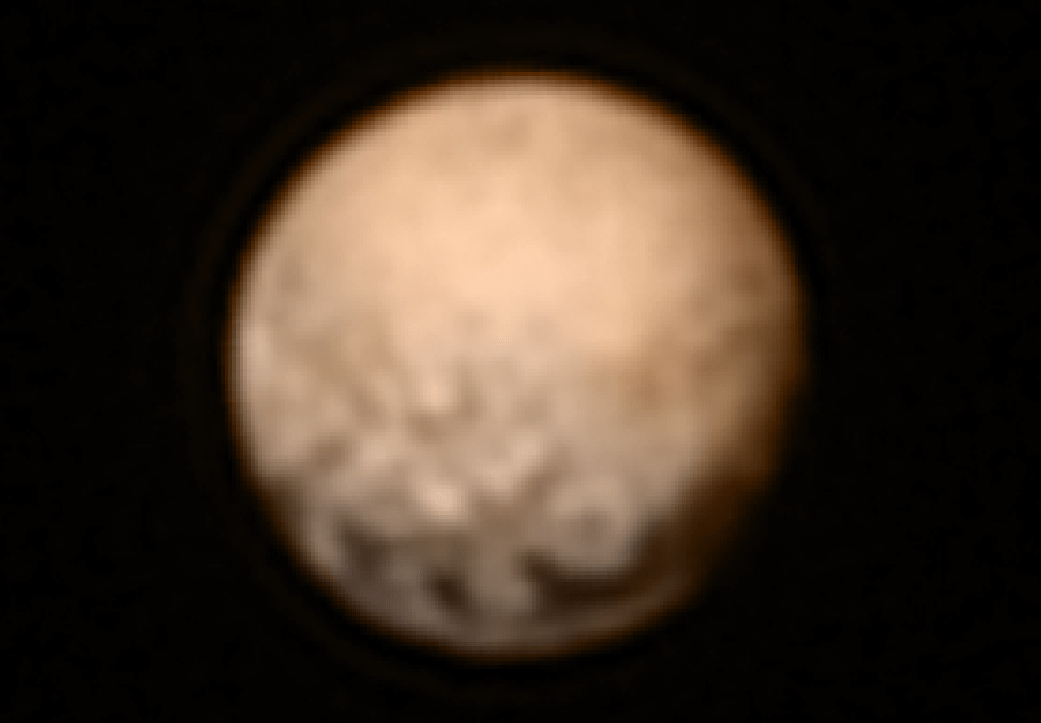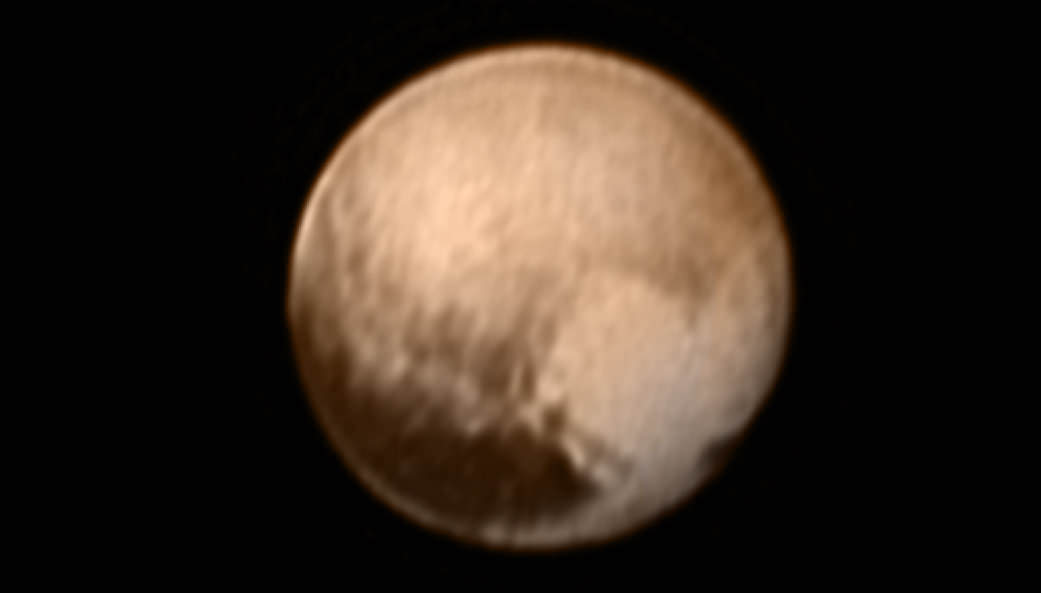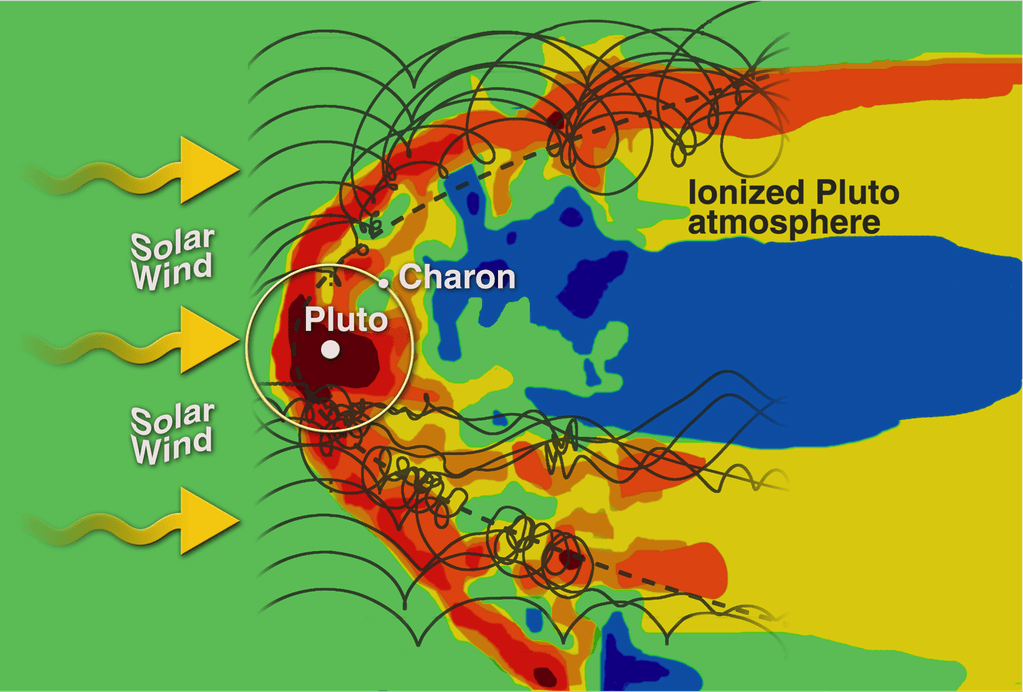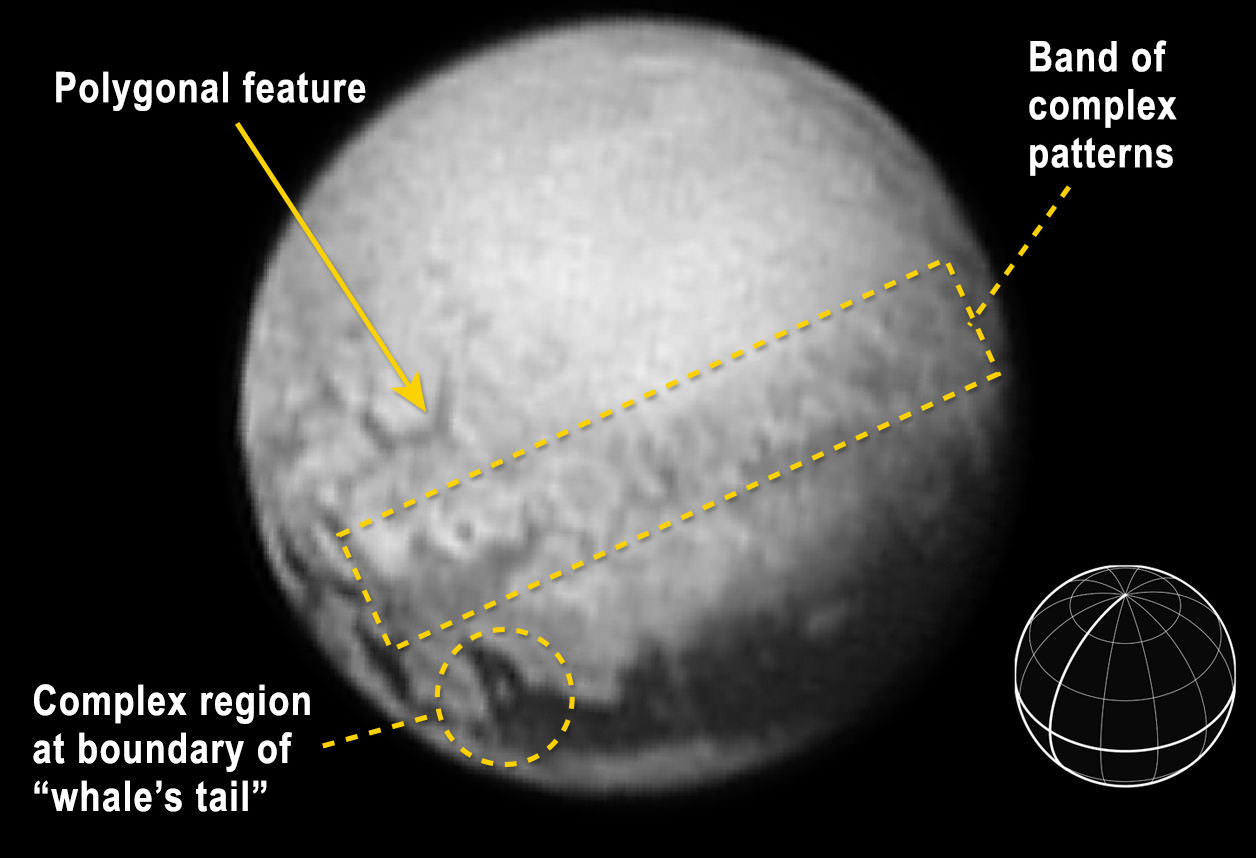New Horizons’ last look at Pluto’s Charon-facing hemisphere reveals the highest resolution view of four intriguing darks spots for decades to come. This image, taken early the morning of July 11, 2015, shows newly-resolved linear features above the equatorial region that intersect, suggestive of polygonal shapes. This image was captured when the spacecraft was 2.5 million miles (4 million kilometers) from Pluto. Credit: NASA/JHUAPL/SWRI
Story updated[/caption]
Today (July 11) we got our last, best and clearest look at a quartet of perplexing dark spots on Pluto’s far side from NASA’s New Horizons spacecraft – now just two days and two million miles (4 million km) out from history’s first ever up close flyby of the Pluto system on Tuesday, July 14.
The four puzzling spots (see above) are located on the hemisphere of Pluto which always faces its largest moon, Charon, and have captivated the scientists and public alike. Pluto and Charon are gravitationally locked with an orbital period of 6.4 days.
Over only the past few days, we are finally witnessing an amazing assortment of geological wonders emerge into focus from these never before seen worlds – as promised by the New Horizons team over a decade ago.
Be sure to take a good hard look at the image, because these spots and Pluto’s Charon-facing hemisphere will not be visible to New Horizons cameras and spectrometers during the historic July 14 encounter as the spacecraft whizzes by the binary worlds at speeds of some 30,800 miles per hour (more than 48,600 kilometers per hour) for their first up close reconnaissance.
And it’s likely to be many decades before the next visitor from Earth arrives at the frigid worlds at the far flung reaches of our solar system for a longer look, hopefully from orbit.
“The [July 11] image is the last, best look that anyone will have of Pluto’s far side for decades to come,” said New Horizons principal investigator Alan Stern of the Southwest Research Institute, Boulder, Colorado, in a statement.
The image of the mysterious spots was taken earlier today (July 11) by New Horizons Long Range Reconnaissance Imager (LORRI) at a distance of 2.5 million miles (4 million kilometers) from Pluto, and just released by NASA. The image resolution is 10 miles per pixel. One week ago it was only 40 miles per pixel.
They were first seen only in very recent LORRI images as Pluto’s disk finally was resolved and are located in a Missouri sized area about 300 miles (480 kilometers) across and above the equatorial region.
But until today they were still rather fuzzy – see image below from July 3! What a difference a few million miles (km) makes!

“The Pluto system is totally unknown territory,” said Dr. John Spencer, New Horizons co-investigator at today’s (July 11) daily live briefing from NASA and the New Horizons team.
“Pluto is like nowhere we’ve even been before. It is unlike anything we’ve visited before.”
Now, with the $700 million NASA planetary probe millions of miles closer to the double planet, the picture resolution has increased dramatically and the team can at least speculate.
Researchers say the quartet of “equally spaced” dark splotches are “suggestive of polygonal shapes” and the “boundaries between the dark and bright terrains are irregular and sharply defined.”
“It’s weird that they’re spaced so regularly,” says New Horizons program scientist Curt Niebur at NASA Headquarters in Washington.
However their nature remains “intriguing” and truly “unknown.”
“We can’t tell whether they’re plateaus or plains, or whether they’re brightness variations on a completely smooth surface,” added Jeff Moore of NASA’s Ames Research Center, Mountain View, California.
“It’s amazing what we are seeing now in the images, showing us things we’ve never seen before,” said Spencer.
“Every day we see things we never knew before. We see these crazy black and white patterns. And we have no idea what these mean.”
Answering these questions and more is what the encounter is all about.
Pluto is just chock full of mysteries, with new ones emerging every day as New Horizons at last homes in on its quarry, and the planet grows from a spot to an enlarging disk with never before seen surface features, three billion miles from Earth after an interplanetary journey of some nine and a half years.
“We see circular things and wonder are those craters? Or are they something else,” Spencer elaborated.
“We saw circular features on Neptune’s moon Triton that are not craters. So we should know in a few days . But right now we are just having an awful lot of fun just speculating. It’s just amazing.”
Until a few days ago, we didn’t know that “the other Red Planet” had a big bright heart and a dark ‘whale-shaped’ feature – see my earlier articles; here and here.

“When we combine images like this of the far side with composition and color data the spacecraft has already acquired but not yet sent to Earth, we expect to be able to read the history of this face of Pluto,” Moore explained.
New Horizons will swoop to within about 12,500 kilometers (nearly 7,750 miles) of Pluto’s surface and about 17,900 miles (28,800 kilometers) from Charon during closest approach at approximately 7:49 a.m. EDT (11:49 UTC) on July 14.
The probe was launched back on Jan. 19, 2006 on a United Launch Alliance Atlas V rocket on a 9 year voyage of over 3.6 billion miles (5.7 billion km).
Pluto is the last of the nine classical planets to be explored up close and completes the initial the initial reconnaissance of the solar system nearly six decades after the dawn of the space age. It represents a whole new class of objects.
“Pluto is a member of a whole new family of objects,” said Jim Green, director of Planetary Science, NASA Headquarters, Washington, in today’s live Pluto update.
“We call that the Kuiper Belt. And it is the outer solar system.”
New Horizons is equipped with a suite of seven science instruments gathering data during the approach and encounter phases with the Pluto system.

The New Frontiers spacecraft was built by a team led by Stern and included researchers from SwRI and the Johns Hopkins University Applied Physics Laboratory (APL) in Laurel, Maryland. APL also operates the New Horizons spacecraft and manages the mission.
Stay tuned here for Ken’s continuing Earth and planetary science and human spaceflight news.



Outer solar system… there is the Oort cloud where gravitational association with the Sun ends – and far beyond the reach of the solar wind, at least anything but “downwind”. Pluto and a good bit of the Kuiper belt are always inside the heliosphere. I think Sedna, Eris, and the like go out of it regularly.
And anyone else what to go out on a limb with the darkest areas being liquid??
My guess is they’re old lava flows, like the Maria on the Moon.
Pluto doesn’t have a molten core, so it couldn’t have had lava flows. Here’s a Universe Today article from 2008 explaining Pluto’s make up.
http://www.universetoday.com/13875/what-is-pluto-made-up-of/
The lava flows would have formed early in Pluto’s history, when the interior was still molten, just like the ones on the Moon.
Dark spots; the letters HELP in an alien language?
No, they spell “A planet’s a planet, no matter how small!” in Plutonian.
Ken,
“Last view” is a bit misleading unless the period between shots is long. If shots are relatively frequent, we’ll only lose detail from this image as it rotates out of view. Some of it will be visible for a while yet, I would think.
We only see a shot every few days. Is this the real frequency of imaging?
Paul
That all depends on if you’re eating enough fibre.
Read the quote from the NH PI Alan Stern in the story – “The image is the last, best look that anyone will have of Pluto’s far side for decades to come.”
You can use the newest and previous snapshots as a stereogram when placed side by side, providing enough relief/depth perspection.
the large crater (bullseye rings) and mountain range really jumps out.
also a plume like feature from the hexagon’s lower left corner is visible, going to center of image.
“Pluto’s far side”? Pluto rotates!
It does has a far side when viewed from Charon because they are tidally locked – but the article also says this is an image of the side facing Charon. Both statements cannot be correct. Either it is Pluto’s near side, or it is the side facing away from Charon.
I’m going out on a limb and say that most of the features we are seeing today were the result of when Pluto and Charon were not tidally locked when Pluto first captured Charon and slowly began to be tidally locked. The atmosphere is too thin to have wiped away all the geology that occurred then. And the pressures on either body was significant.
The features that we can see now are tantalizing but I worry that there is a huge contribution from the heavy processing that is going on. It may wipe out some real features and create false ones. “Processing artifacts”, y’know.
Didn’t we read that the Pluto-Charon system completes a revolution in approximately six days? These pictures are from what, three days out?
The side we will see as NH passes by Pluto will be the side we can’t see in this shot.
I believe that vindicates Dr. Stern.
Pete,
There is no doubt that the side we will see as NH passes by Pluto will be the side we can’t see in this shot. It was in full sun on the 11th so it will be in darkness on the 14th. And if it’s really the far side it is never lit by Charon’s moon shine, so it will be too dark to image.
But it cannot possibly be both “Pluto’s far side” and “the side facing Charon”. Charon is the only object in synchronous orbit, so it’s the only place from which the term “far side” makes sense.
If the probe is to pass between Pluto and Charon, Dr. Stern was correct. Otherwise he may have been misquoted, or he may have meant to say “near side”. My guess is, he was misquoted.
But the author contradicted himself in the article. Which is understandable; these articles are written and posted so fast there can’t be much time for proofreading.
The near side and far side are very likely to look different due to Charon’s tidal effects. It will be fascinating to compare them and it’s a shame we won’t get to see both at high res!
I just looked at the trajectory and the probe’s closest approach will indeed be to Pluto’s far side (placing both Pluto and Charon in full sunlight).
So the image here, from the 11th, is of the near side. It’s the best shot of the entire near side we’ll get, but we will still see parts of it at higher res as Pluto rotates over the next few days.
Dr. Kremer,
Something I may be missing, but it might help if somehow the orientation of the Pluto-Charon system to the approach path of NH could be illustrated in more than one view. Perhaps something like the three perpendicular views used for objects represented by “old-time” engineering drawings.
(I’m old. That’s something I would understand.)
Or an “isometric” (three quarter view). Ideally it would show where NH and Pluto and Charon are with respect to each other at the point of closest encounter. The other four satellites should be shown if it doesn’t make the diagram too complicated.
A modern video could be great, with multi-point perspectives as some have done for other fly-bys.
KEN IS CERTAINLY RIGHT, IT IS 8
http://i2.photobucket.com/albums/y33/HeadAroundU/KEN%20IS%20RIGHT%20IT%20IS%208.jpg